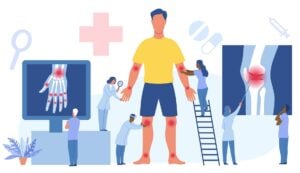

Most clinical trials are developed, funded and managed by pharmaceutical or medical device companies. Here at Genesis Research, we also conduct “investigator-initiated studies”. These are research studies that are developed and managed by our own doctors and research team.
Investigator-initiated studies are subject to all the same regulations, safety standards, and ethical review as sponsored clinical trials. Some investigator-studies are fully funded by the doctor(s)/investigator(s) themselves, or the institution or hospital in which they are conducted. Others may be funded by government research grants. Those that involve a commercial product may be funded by an external research grant from the company, but they do not manage the study.
We are currently conducting an investigator-initiated study for patients living with chronic neuropathic low back pain who are suitable for a trial of spinal cord stimulation (SCS). Click here to view the study information and apply.
SCS is an advanced neuromodulation therapy for chronic pain patients who have not achieved sufficient pain relief with medications or other conventional treatments. You can read more about SCS and other neurostimulation therapies here.
SCS therapy involves surgical implantation of stimulating leads (electrodes) into the epidural space in the spine. The leads are connected to a pulse generator (stimulator/battery), which is usually implanted under the skin on the lower backside. The system delivers electrical pulses to the spinal cord, which interrupt or alter nerve activity and block pain signals from travelling to the brain. SCS is able to target different areas of pain, depending on where the leads are positioned along the spinal cord.

Before receiving a permanent implant, patients will trial SCS with implanted leads and an externally worn pulse generator for around a week to see if it provides sufficient benefits (i.e. 50% or more pain relief, functional improvements, medication reduction).
Patients who receive a permanent implant will have personalised programming sessions with a company engineer/programmer, who will tweak the stimulation parameters to get the best possible pain relief and coverage for the patient.
Traditional SCS produces a tingling sensation (i.e. “pins-and-needles”) known as paraesthesia. Nowadays, there are several paraesthesia-free options (you don’t feel anything). Paraesthesia vs paraesthesia-free SCS is achieved by programming different stimulation parameters, which changes the “waveform” of electrical energy delivered to the spinal cord.
In this study, eligible patients are given the opportunity to trial new stimulation programs (waveforms) that may offer improved outcomes and quality of life. One new waveform will be trialled during the SCS trial, and if the trial is successful, the patient may choose to proceed to permanent implantation with a commercial SCS system. Patients will trial 4 new stimulation waveforms for up to 12 months. Study patients receive the same standard of care as any other SCS patient but will attend additional study visits and study programming sessions. Study patients may or may not benefit from the trial itself.
View our currently recruiting studies:
Register your interest for future studies:
© Genesis Research Services, 2023